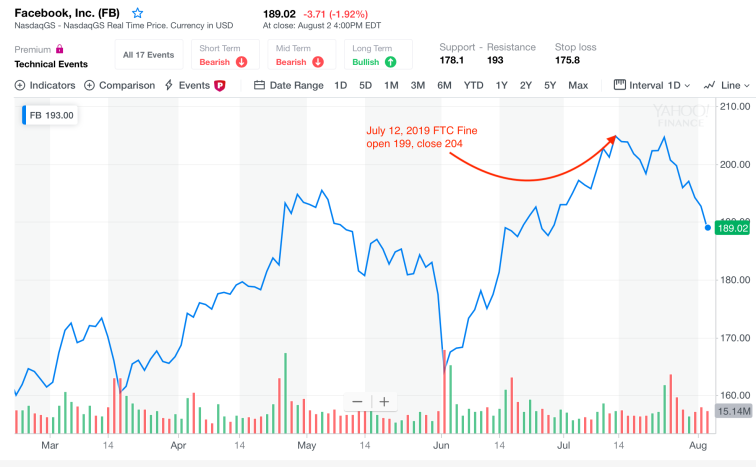Senator Josh Hawley recently introduced the The Social Media Addiction Reduction Technology (SMART) Act which is legislation to go after social media addiction. His main line of attack is through addressing and limiting functionality (you can just hear the handwringing now from the EFF, Public Knowledge, Engine and R Street about censorship, innovation, etc., etc.)
Of course, one underlying issue is what appears to be the endemic loneliness and withdrawal of children and adults. If you doubt that, just try a search for “12 step social media addiction” or “12 step gaming addiction” or “12 step internet addiction.” There are a bunch and that usually means the harm is widespread. Any fines that result from enforcing regulations against the social media profiteers should definitely be spread around to these groups who could put those resources to good use. All the legislation in the world is unlikely to resolve these underlying social issues.
While Senator Hawley’s ideas have merit, there’s a couple of simple fixes that he might also want to consider. These fixes sound in our experience in regulating the tobacco industry, or “Big Tobacco.”
I am deeply concerned–as I think artists and songwriters are–that among all the other bad things Big Tech does with music, one big attraction for them is that music is a honeypot for addiction. So I think we should all care about that. There are also some policy lifts that don’t just concern us and should be socialized to the broader electorate if for no other reason than the harms affect us all. Not only are we affected, but I would argue that the harms are doing exactly what they are designed to do–get our children addicted in campaigns that are just as insidious as the Joe Camel campaign. I’m going to briefly look at the tobacco and social media addictions and then lay out the three ideas.
Tobacco Addiction Additives
I look at social media behavioral addiction through a single lens: It’s very similar to commercial tobacco substance addiction. Tobacco is a natural substance that has some addictive properties. As anyone who has seen Mad Men or followed the work of Edward Bernays will tell you, Big Tobacco conducts sophisticated marketing campaigns to sell its product and the delivery system to the addict–cigarettes instead of needles.
You’ve seen this kind of marketing manipulation–Joe Camel, for example, was tasked with making cigarette smoking cool for kids.

But in addition to marketing, Big Tobacco has used science to make their product even more addictive. A good primer on this more insidious aspect of their business is the movie The Insider starring Russell Crowe in the role of the whistleblower Dr. Jeffrey Wigand, the former director of research for the Brown & Williamson tobacco company. As Dr. Wigand famously told Mike Wallace on 60 Minutes, “we’re a nicotine delivery business.”

Dr. Wigand’s research also disclosed what he called the intentional and unintentional additives to tobacco:
Tobacco products are not “natural” products that contain harmless ingredients. Rather, a typical cigarette can contain numerous intentional additives. However, virtually nothing is known about these ingredients. Even worse, nothing is known about the unintentional additives that are the by-products of the growing, handling and manufacture of tobacco products. These unintentional additives or contaminants include pesticides, herbicides and ink from the packaging materials. We are in the dark about how these unintentional additives are affected when burned in conjunction with nicotine and when combusted with other intentional additives.
One big difference between tobacco and social media is that there are no unintentional additives to social media. All are man-made and under the control of humans, Mrs. Palsgraf. I’ve always said that there is a “Pinto memo” out there somewhere at Facebook, Google, Amazon or Twitter and that Big Tech is going to get taken down by a Jeffrey Wigand-style whistleblower who just can’t take it anymore. (See Grimshaw v. Ford Motor Co., 119 Cal.App.3d 757 (1981)

DSM 5 and Internet Gaming Disorder
Let’s have a look at the Diagnostic and Statistical Manual of Mental Disorders (DSM-5), the shrink’s bible. What does DSM-5 say about it?
In the fifth edition of the Diagnostic and Statistical Manual of Mental Disorders (DSM-5), Internet Gaming Disorder is identified in Section III as a condition warranting more clinical research and experience before it might be considered for inclusion in the main book as a formal disorder.
A New Phenomenon
The Internet is now an integral, even inescapable, part of many people’s daily lives; they turn to it to send messages, read news, conduct business, and much more. But recent scientific reports have begun to focus on the preoccupation some people develop with certain aspects of the Internet, particularly online games. The “gamers” play compulsively, to the exclusion of other interests, and their persistent and recurrent online activity results in clinically significant impairment or distress. People with this condition endanger their academic or job functioning because of the amount of time they spend playing. They experience symptoms of withdrawal when pulled away from gaming.
This means that the editorial board of DSM thought there was enough of an issue with Internet Gaming Disorder to warrant including it in DSM-5 with the suggestion that the phenomenon deserved further study with an eye toward including it as a formal disorder.
A closely associated phenomenon is “Internet Addiction Disorder” which is the more generalized version of Internet Gaming Disorder. “IAD” like “IGD” has not been officially codified within a psychopathological framework, it is the subject of considerable interest and research. If I had to bet, I would bet that Google uses its academic shills to slow down codification.
In a search of relevant peer reviewed articles at the National Institutes of Health, I came across this title written by a number of doctors:
The abstract describes the findings:
INTRODUCTION:
Internet addiction disorder (IAD) is characterized by the problematic use of online video games, computer use, and mobile handheld devices. While not officially a clinical diagnosis according to the most recent version of the Diagnostic and Statistical Manual of Mental Disorders (DSM), individuals with IAD manifest severe emotional, social, and mental dysfunction in multiple areas of daily activities due to their problematic use of technology and the internet….CONCLUSIONS:
Over the course of his 35-day residential treatment, the patient noted a reduction in irritability, reduction in motor movements to his temple to turn on the device, and improvements in his short-term memory and clarity of thought processes. He continued to intermittently experience dreams as if looking through the device. To our knowledge, this is the first reported case of IAD involving problematic use of Google Glass™.
And that’s just Google Glass, a product that failed in its 2015 launch but that Google relaunched in 2017 with its “Enterprise Edition.”
Another peer reviewed article at NIH stated:
[S]udden cessation of online social networking (i.e., lack of Internet connection) may in some chronic users cause signs and symptoms that at least partially resemble the ones seen during drug/alcohol/nicotine abstinence syndrome.
Other relevant reading should include Development of a Facebook Addiction Scale, Andreassen et al (2012).
The cracks are starting to show. In a USA Today op ed by Roger McNamee, who runs a venture capital outfit called Elevation Partners said:
I invested in Google and Facebook years before their first revenue and profited enormously. I was an early adviser to Facebook’s team, but I am terrified by the damage being done by these Internet monopolies….
Facebook and Google get their revenue from advertising, the effectiveness of which depends on gaining and maintaining consumer attention. Borrowing techniques from the gambling industry, Facebook, Google and others exploit human nature, creating addictive behaviors that compel consumers to check for new messages, respond to notifications, and seek validation from technologies whose only goal is to generate profits for their owners….
How does this work? A 2013 study found that average consumers check their smartphones 150 times a day. And that number has probably grown. People spend 50 minutes a day on Facebook. Other social apps such as Snapchat, Instagram and Twitter combine to take up still more time. Those companies maintain a profile on every user, which grows every time you like, share, search, shop or post a photo. Google also is analyzing credit card records of millions of people….
Consider a recent story from Australia, where someone at Facebook told advertisers that they had the ability to target teens who were sad or depressed, which made them more susceptible to advertising. In the United States, Facebook once demonstrated its ability to make users happier or sadder by manipulating their news feed. While it did not turn either capability into a product [yet, that we know of], the fact remains that Facebook influences the emotional state of users every moment of every day. Former Google design ethicist Tristan Harris calls this “brain hacking.”
So both the literature and the anecdotal evidence of insiders leads us to believe that Senator Hawley’s bill is addressing a serious and pervasive societal harm from behavioral addiction profiteers.
Behavioral Addiction Additives
We’re all familiar with the view-selling and fake views problems with YouTube. Michael H. Keller in the New York Times takes a deep dive into the skullduggery behind fake views. Mr. Keller’s post ends with this provocative conclusion:
View-selling sites continue to advertise with apparent impunity. A post on the YouTube Creator Blog warning users against fake views has numerous comments linking to view-selling sites.
“The only way YouTube could eliminate this is if they removed the view counter altogether,” said Mr. Vassilev, the fake-view seller. “But that would defeat the purpose of YouTube.”
That’s an interesting proposition. Why would removing the view counter defeat the purpose of YouTube? One reason might be that subscriber count is a function of view count, and subscriber count is tied to compensation and perks for YouTube creator channels.
But what about artists? Can you imagine a marketing plan that doesn’t include YouTube? Aren’t we told that artists can’t reach an audience without YouTube? So isn’t the purpose of YouTube to reach an audience rather than produce public views information? Granted, the person making that assertion is a fake view seller and not a YouTube representative, but a YouTube representative would likely never say such a thing even if they knew it to be true. Why not?
One reason might be that the view counter, friend counters, the likes, the retweets, the various measurements that demonstrate the re-enforcement of acceptance by “friends”, are an important component of what makes YouTube addictive, just like tobacco companies added ammonia and other chemicals to tobacco to increase its addictive powers. And the evidence is starting to come in suggesting that it is that addiction that is the real purpose of YouTube and other social media sites. Senator Hawley’s legislation seeks to control “badges” and the like for users (not creators) unless they increase access to goodies–and I would pick a bone on that clause because it still allows the exploitation of addictive behavior in exactly the manner that should be limited. By allowing YouTube to integrate measurable success of YouTubers at getting users hooked on a channel, the legislation leaves an enormous loophole and you can bet Google will exploit it.
One source of evidence for social media addiction is from Professor Adam Alter of the NYU Stern School of Business whose book Irresistible: The Rise of Addictive Technology and the Business of Keeping Us Hooked describes in shocking detail just how devious sites like YouTube and Facebook are in delivering the dopamine fix to our brains, and worse yet to our children’s brains. As Professor Alter told the New York Times:
Today, we’re checking our social media constantly, which disrupts work and everyday life. We’ve become obsessed with how many “likes” our Instagram photos are getting instead of where we are walking and whom we are talking to….
We are engineered in such a way that as long as an experience hits the right buttons, our brains will release the neurotransmitter dopamine. We’ll get a flood of dopamine that makes us feel wonderful in the short term, though in the long term you build a tolerance and want more….
I find it interesting that the late Steve Jobs said in a 2010 interview that his own children didn’t use iPads. In fact, there are a surprising number of Silicon Valley titans who refuse to let their kids near certain devices. There’s a private school in the Bay Area and it doesn’t allow any tech — no iPhones or iPads. The really interesting thing about this school is that 75 percent of the parents are tech executives.
They care about kids, too. Just not your kids.
And of course those dopamine hits include YouTube subscriber and view counts, Facebook friends and likes and the various other feedback mechanisms that enforce a measurement of public popularity. Popularity that is an especially powerful motivation for lonely people.
So far, social media addiction profiteering is good business as Spotify billionaire Sean Parker tells us:
“It’s a social-validation feedback loop … exactly the kind of thing that a hacker like myself would come up with, because you’re exploiting a vulnerability in human psychology.”
“God only knows what it’s doing to our children’s brains,” Parker said.
Of course, as one Silicon Valley entrepreneur who also survived the Dot Bomb Implosion once told me, there’s something really wrong about a world in which Sean Parker is a billionaire.
None of this should come as a surprise–YouTube has a long history of failing to protect children from a host of unsavory activities on YouTube. A must read post by James Bridle tells us of the truly bizarre goings on at YouTube Kids.
I’ve also been aware for some time of the increasingly symbiotic relationship between younger children and YouTube. I see kids engrossed in screens all the time, in pushchairs and in restaurants, and there’s always a bit of a Luddite twinge there, but I am not a parent, and I’m not making parental judgments for or on anyone else. I’ve seen family members and friend’s children plugged into Peppa Pig and nursery rhyme videos, and it makes them happy and gives everyone a break, so OK.
But I don’t even have kids and right now I just want to burn the whole thing down.
Someone or something or some combination of people and things is using YouTube to systematically frighten, traumatise, and abuse children, automatically and at scale, and it forces me to question my own beliefs about the internet, at every level.
Given all the harms of social media and the willingness of addiction profiteers to do evil, let’s consider some potential fixes that don’t necessarily involve a knock down drag out legislative fight.
The Three Fixes
Given the similarities to internet addiction and tobacco addiction, let’s take a few ideas from the tobacco regulation campaign that could easily be added on to Senator Hawley’s legislation.
Mandatory Addiction Warning
We know that Big Tech will simply ignore the law until there is a final, nonappealable judgement against them in every jurisdiction conceivable at which point the legislation will be watered down so as to be unrecognizable. So rather than try to control their functionality, simply require that if they don’t change the functionality they have to put a prominent warning on all pages of their addiction delivery business…I mean, their sites. And this is something that could probably be done today through FTC regulations or as part of settlements with DOJ or FTC. One of the harms that the FTC could control for would be data scraping and profiling (which of course is one of the many reasons that user capture through addiction is so profitable), as well as false advertising.

Private Cause of Action
The remedies part of Senator Hawley’s legislation does not really get to what strikes fear into the hearts of Big Tech companies: Getting sued by their users, particularly if those suits result in an injunction or really huge tobacco industry level damages.
Bear in mind that Google and Facebook laugh off multi-billion fines of $5 billion or less. We are not accustomed to this in the law. If you said Ford had to pay a $5 billion fine, the stock would tank. When Facebook got a $5 billion fine, their stock went up. We don’t really know the upper boundaries of that dollar figure.

But we do know that the damages part of a private cause of action has to be huge. What I have in mind is a $50 billion class action award, in other words about 10 times what we are accustomed to as a penalty. I know that sounds a little extreme, maybe quite extreme, but that’s what it will take if the purpose is to change behavior.
I would point out that the $200 billion 1998 Tobacco Master Settlement Agreement involved 48 states led by Mississippi Attorney General Mike Moore recovering their Medicaid costs of treating tobacco-related health care costs from the four largest United States tobacco companies (Philip Morris Inc., R. J. Reynolds, Brown & Williamson and Lorillard). I don’t think that there’s any reason the same case could not be made against Google, Facebook, Twitter and possibly Amazon (the millennial answer to the Home Shopping Network).
Ask the Government Science Agencies for Their Research the Issue
As a U.S. Senator, Sen. Hawley could simply ask the National Institutes of Health or the National Academy of Sciences for their existing research on the issue. If they haven’t studied the problem (which I doubt), Senator Hawley can probably get a bipartisan consensus to get them to conduct a front-burner study on the subject.
He may find he is pushing on an open door. A 2014 study commissioned by Facebook “Experimental evidence of massive-scale emotional contagion through social networks” written by Adam D. I. Kramer of Facebook’s “Core Data Science Team” and two academics from Cornell. (Cornell was one of the first campuses outside of Harvard to adopt the early version of Facebook) was published in the Proceedings of the National Academy of Sciences but carried an “Editorial Expression of Concern” regarding the study’s methodology:
Questions have been raised about the principles of informed consent and opportunity to opt out in connection with the research in this paper. The authors noted in their paper, “[The work] was consistent with Facebook’s Data Use Policy, to which all users agree prior to creating an account on Facebook, constituting informed consent for this research.”When the authors prepared their paper for publication in PNAS, they stated that: “Because this experiment was conducted by Facebook, Inc. for internal purposes, the Cornell University IRB [Institutional Review Board] determined that the project did not fall under Cornell’s Human Research Protection Program.” This statement has since been confirmed by Cornell University.
Obtaining informed consent and allowing participants to opt out are best practices in most instances under the US Department of Health and Human Services Policy for the Protection of Human Research Subjects (the “Common Rule”). Adherence to the Common Rule is PNAS policy, but as a private company Facebook was under no obligation to conform to the provisions of the Common Rule when it collected the data used by the authors, and the Common Rule does not preclude their use of the data. Based on the information provided by the authors, PNAS editors deemed it appropriate to publish the paper. It is nevertheless a matter of concern that the collection of the data by Facebook may have involved practices that were not fully consistent with the principles of obtaining informed consent and allowing participants to opt out.
My bet is that it wouldn’t take much more than a request from a Senator to get some real research going on this subject. The challenge, of course, would be to keep Google, Facebook and Twitter from trying to control that research through their various astroturf front groups and academics.

Thank you! Hell yes!!!! Maria
Sent from my iPhone
>
LikeLike